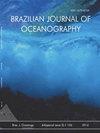Subtidal soft sediments of the Paranaguá Bay inlet: mapping habitats and species distribution at a landscape scale
Q2 Earth and Planetary Sciences
引用次数: 2
Abstract
This study aimed to map habitats and species distribution in a benthoscape section of the Paranaguá Bay inlet, Paraná State, Southern Brazil. The degree of correspondence between maps independently generated through sidescan imagery and macrofauna and sediment samples was also evaluated. The study area had approximately 9km2 and was chosen considering both diverse landscape features and proximity to future port developments. Sampling was performed in 67 evenly distributed and unreplicated sites. Patterns related to backscatter intensity (high and low) and the presence or absence of bedforms were observed, as well as other large-scale features like sand waves and beach rock outcrops. Local sedimentary environments were represented in a mosaic used for comparisons with sedimentary and faunistic data. Cluster analysis using grain size data formed four groups with similar particle size distribution. A strong correspondence between habitats and grain size distribution was found in only one habitat class. Macrofauna around the deeper Poço Point region and the Mel Island shallower banks presented high species richness and number of individuals. These were considered habitats of high biological relevance. Regions with bedforms indicate higher rates of sand transport in which a few species can thrive. The navigation channel had the lowest number of species and individuals when compared to vicinal regions, indicating persistent impacts. The study evidenced local estuarine bottom heterogeneity and contributed to the understanding of local processes of both bottom sediments dynamics and their associate faunal components. AbstrAct Orlei Antonio Negrello-Filho1,2* , Juan Carlos Ugaz-Codina2, Luiz Henrique Sielski de Oliveira1, Maria Cristina de Souza1, Rodolfo José Angulo1帕拉纳瓜湾入口的潮下软沉积物:景观尺度上的栖息地和物种分布
本研究旨在绘制巴西南部帕拉纳州帕拉纳湾入口底栖景观部分的栖息地和物种分布。通过侧扫描图像独立生成的地图与大型动物和沉积物样本之间的对应程度也进行了评估。研究区面积约9平方公里,在选择时考虑了不同的景观特征和邻近未来港口的发展。在67个均匀分布和不重复的地点进行抽样。观察到与后向散射强度(高和低)和存在或不存在的床型有关的模式,以及其他大规模特征,如沙波和海滩岩石露头。局部沉积环境用马赛克表示,用于与沉积和动物资料进行比较。利用粒度数据进行聚类分析,形成粒径分布相似的四组。只有一个生境类的生境与粒径分布有较强的对应关系。在poo Point较深地区和Mel Island较浅海岸周围的大型动物具有较高的物种丰富度和个体数量。这些被认为是具有高度生物学意义的生境。有河床的地区表明沙的迁移率较高,其中一些物种可以茁壮成长。与周边地区相比,航道的物种和个体数量最少,表明影响持续存在。该研究证明了当地河口底部的异质性,有助于了解当地的底部沉积物动力学过程及其相关的动物成分。Orlei Antonio negrello - filho1,2 *, Juan Carlos ugaz - codin2, Luiz Henrique Sielski de Oliveira1, Maria Cristina de souz1, Rodolfo jossore Angulo1
本文章由计算机程序翻译,如有差异,请以英文原文为准。
求助全文
约1分钟内获得全文
求助全文
来源期刊
CiteScore
2.30
自引率
0.00%
发文量
0
审稿时长
>12 weeks
期刊介绍:
The Brazilian Journal of Oceanography covers the entire spectrum of disciplines within the science of oceanography, publishing articles dealing with the biological oceanography, physical oceanography, marine chemistry, sedimentology and geology, from coastal and estuarine waters out to the open sea. Emphasis is placed on inter-disciplinary process-oriented contributions. BJO also publishes issues dedicated to results of scientific meetings and of large inter-disciplinary studies or topical issues on specific subjects.
The audience is composed by physical, chemical and biological oceanographers, marine sedimentologists, geologists and geochemists, marine biologists and ecologists.
Papers sent to BJO must present results from original research and be written in english.

 求助内容:
求助内容: 应助结果提醒方式:
应助结果提醒方式:


